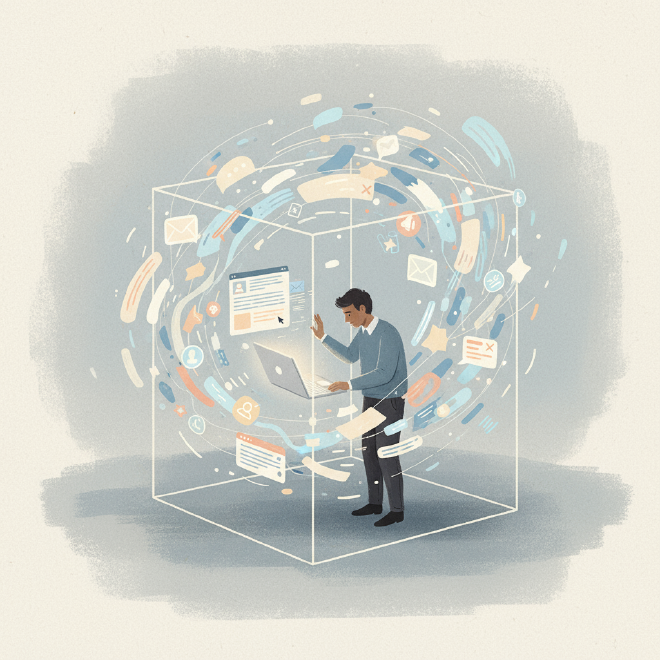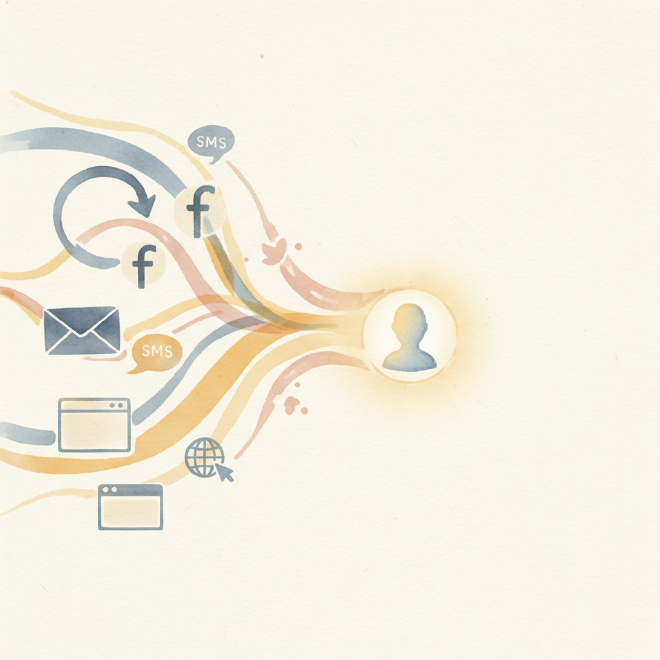Multichannel Email Marketing: Boost Engagement & Conversions
Table of Contents
Supercharge Your Email Strategy: The Multichannel Playbook for Higher Engagement and Conversions #
Meta Description: Unlock higher engagement and conversions by integrating email marketing with other digital channels. Learn practical strategies for a cohesive customer journey, from social segmentation to B2B outreach, and move beyond generic email blasts.
You know that feeling, right? You’ve poured your heart and soul into crafting the perfect email campaign. The subject line is punchy, the body copy sings, the CTA is crystal clear. You hit “send,” hold your breath… and then, crickets. Or maybe a trickle of opens, a few clicks, but nothing that really moves the needle.
It’s frustrating, isn’t it? Especially when you know email marketing can be a powerhouse. But here’s the thing: in today’s noisy digital world, relying solely on email is a bit like trying to win a chess match with only pawns. It’s just not enough anymore. Your customers? They’re everywhere. They’re scrolling through Instagram, catching up on LinkedIn, maybe even getting a quick text alert. And honestly, they expect you to be there too, in a way that feels natural and, well, human.
If your email campaigns feel like they’re shouting into the void, or if you’re struggling to really connect with your audience and drive those conversions, then you’re in the right place. We’re about to dive into the world of multichannel email marketing – and trust me, it’s a game-changer. This isn’t just about sending the same message on every platform; it’s about orchestrating a symphony where each channel plays its part, creating a beautiful, unified experience for your customers.

Ready to stop feeling like your email efforts are stuck in a silo? Let’s talk about how to get your messages resonating across the digital landscape, building stronger relationships and, yes, driving those all-important sales.
Why “Email-Only” Just Doesn’t Cut It Anymore (And What to Do About It) #
Look, email is still king for direct communication. Absolutely. It’s permission-based, personal, and has an incredible ROI when done right. But think about your own online habits for a second. Do you only check email? Of course not! You jump from social media to a quick search, maybe watch a YouTube video, then back to email. Your customers are doing the exact same thing.
Their journey isn’t linear. It’s a messy, beautiful, convoluted path, and if you’re only showing up in one spot, you’re missing huge opportunities to connect. The limitations of email-only campaigns are becoming painfully clear:
- Diminishing Returns: Open rates can plateau. Click-throughs might dip. Why? Because everyone’s inbox is a battlefield.
- Siloed Data: If your email team doesn’t talk to your social media team, or your sales team, you’re essentially starting from scratch with each interaction. That’s a lot of wasted effort, and a really disjointed experience for your customer.
- Missed Context: An email might be great, but what if a customer just interacted with your brand on Instagram? Or visited a specific product page? Without that context, your email can feel generic, even irrelevant.
- Customer Expectations: People expect personalization. They expect you to “get” them. And they expect you to be accessible on their preferred channels.
So, what’s the answer? It’s not abandoning email. It’s amplifying it. It’s about creating an omnichannel customer journey where email isn’t just a standalone tool, but a crucial, integrated piece of a much larger, more effective puzzle.
What Even Is Multichannel Email Marketing, Really? #
Okay, let’s clear something up. Multichannel isn’t just sending your newsletter to your email list and posting it on Facebook. That’s just broadcasting the same message in multiple places. While there’s a time and place for that, true multichannel marketing is much more sophisticated.
It’s about cohesion, sequencing, and data sharing across every touchpoint. Think of it like this:
- It’s a Conversation, Not a Monologue: You’re not just talking at your customer; you’re engaging them in a continuous dialogue, adapting your message based on their actions (or inactions) on different platforms.
- It’s About the Customer’s Journey: Instead of thinking “email campaign,” think “customer journey.” Where are they? What do they need? How can we best serve them right now, using the most effective channel?
- It’s Data-Driven: Information gathered from one channel (like a click on a social ad) should inform your strategy on another (like a follow-up email). This is where the magic really happens, allowing for incredible social media email segmentation and personalized experiences.
The goal? To meet your audience where they are, with the right message, at the right time, creating a seamless and delightful experience that feels less like marketing and more like genuine connection.

The Psychological Punch of a Coordinated Approach #
Why does this multichannel thing work so well? It’s not just about being everywhere; there’s some solid psychology behind it.
- Consistency Breeds Trust: When your brand voice, messaging, and even visual style are consistent across email, social, and other platforms, it builds trust. It tells your customer you’re organized, professional, and reliable. And trust, as we all know, is the bedrock of any strong relationship, especially a commercial one.
- Reinforcement & Recall: Ever heard something once and forgotten it, but heard it three times and it stuck? That’s reinforcement. A message delivered via email, then subtly echoed on social media, then perhaps followed up with a LinkedIn connection, significantly increases recall. Your brand stays top-of-mind.
- Meeting Them Where They Are: People have preferences. Some love email for detailed info, others prefer quick updates on social. By being present on multiple channels, you cater to these preferences, making it easier for them to engage with you on their terms. It feels thoughtful, not pushy.
- The “Oh, You Get Me” Factor: When a social ad pops up for something you just looked at on their website (after clicking an email link, perhaps?), it feels a little magical, doesn’t it? That’s personalization in action. It shows you’re paying attention, which fosters a sense of being understood and valued.
These aren’t just warm fuzzy feelings; they translate directly into higher engagement, better conversions, and ultimately, a more loyal customer base.
Your Multichannel Playbook: Practical Strategies to Implement Today #
Alright, enough theory. Let’s get into the nitty-gritty. Here are some actionable multichannel email marketing strategies you can start weaving into your plans right now.
Strategy 1: Welcome Flows That Wow (Email + Social Retargeting) #
Think about your welcome sequence. It’s often the first real conversation you have with a new subscriber. But what if you could make it even more impactful?
- The Play: When someone signs up for your email list, trigger your standard welcome email. But simultaneously, add them to a custom audience on Facebook or Instagram. For the next 3-5 days, show them a few targeted ads that reinforce your welcome message, highlight your key value propositions, or showcase a popular product/service.
- Why it Works: It’s not just an email; it’s an immersive brand introduction. The social ads act as a visual reminder and provide another touchpoint, increasing brand familiarity and trust right out of the gate.
- Example: A new subscriber gets a welcome email with a discount code. Over the next few days, they see Instagram ads featuring products where that discount code would apply, or testimonials from happy customers. This reinforces the offer and builds excitement.
Strategy 2: Nurturing Leads Beyond the Inbox (Email + LinkedIn for B2B) #
For B2B marketing, especially, LinkedIn email sequences are a goldmine. Email is great for detailed content, but LinkedIn adds a layer of professional connection.
- The Play: You send a valuable lead magnet (eBook, whitepaper) via email. If a prospect opens it and engages, a few days later, connect with them on LinkedIn with a personalized message referencing the content they downloaded. Follow up with a relevant piece of content or a brief question.
- Why it Works: It moves the relationship from a transactional email interaction to a more personal, professional connection. A LinkedIn message feels less like marketing and more like networking, opening doors for deeper conversations.
- Example: After a prospect downloads your “Guide to SaaS Sales Funnels” via email, you connect on LinkedIn with a message like, “Hi [Name], saw you downloaded our SaaS sales funnel guide – hope you found it useful! I’m always keen to connect with others passionate about optimizing sales processes. Let me know if any part of the guide sparked questions.”
Strategy 3: Rescuing Abandoned Carts (Email + SMS/Push Notifications) #
This one is classic, but often under-leveraged in its multichannel potential. An abandoned cart is a clear sign of interest, but something stopped them.
- The Play: Send your standard abandoned cart email. If there’s no action within an hour or two, follow up with a quick, friendly SMS (if you have permission!) or a browser push notification, simply reminding them their cart is waiting.
- Why it Works: Urgency. Different channels hit different levels of immediacy. Email is good, but an SMS or push notification often gets seen much faster, especially for a time-sensitive reminder. It’s about gently nudging them back to complete the purchase.
- Example: “Hey [Name], still thinking about those [Product Name] in your cart? They’re waiting for you! Click here to complete your order: [link]”
Strategy 4: Supercharging Segmentation with Social Data #
This is where your email lists get really smart. Social media email segmentation takes personalization to the next level.
- The Play: Track engagement on your social media posts. Who’s liking, commenting, sharing your content about Product A vs. Product B? Use this data to create dynamic segments within your email platform.
- Why it Works: Instead of guessing interests, you’re using explicit engagement data. This allows you to send highly targeted emails that resonate deeply because you know what they care about.
- Example: A follower consistently engages with your Instagram posts about eco-friendly products. You can segment them into a “Green Enthusiasts” list and send them emails specifically about new sustainable product lines, rather than general promotions.
Making It All Work: The Tech Side of Multichannel Magic #
Okay, so you’re probably thinking, “This sounds amazing, but also… complicated.” And you’re not wrong! Orchestrating a truly effective multichannel strategy requires a bit of planning and, crucially, the right tools.
This is where a robust email marketing integration platform becomes your best friend. You need a system that can:
- Handle Automation: Building those visual workflows where actions on one channel trigger responses on another is non-negotiable.
- Manage Contacts Seamlessly: All your contact data – email engagement, social interactions, purchase history – needs to be in one place, allowing for easy segmentation and dynamic grouping. No more messy spreadsheets or siloed information.
- Provide Clear Analytics: How do you know what’s working? You need a dashboard that gives you real-time insights across your campaigns – delivery rates, open rates, CTRs, even unsubscribe rates – so you can optimize on the fly.
- Protect Your Reputation: When you’re sending more targeted emails, you want to make sure they actually land in the inbox. A good platform will help with domain reputation protection and invalid address filtering.
And honestly, this is where a really good email marketing platform comes in handy. One that lets you build those visual workflows, segment your contacts dynamically, and gives you clear analytics on what’s actually happening. You know, the kind of platform that takes the headache out of integration and helps you protect your sender reputation? If you’re looking for a tool that makes this kind of multichannel strategy not just possible, but easy, you might want to explore options that offer robust features and flexible pricing, especially if you’re a small business or growing team. Just something to consider: Explore powerful email marketing solutions here.
Ready to Get Started? #
The digital landscape is always evolving, and our marketing strategies need to evolve with it. The days of treating email as a standalone tactic are, honestly, behind us. Customers expect a cohesive, personalized journey, and cross-channel marketing is how you deliver it.
It might feel like a big leap, but start small. Pick one of the strategies above and experiment. See how your audience responds. Track your results. You’ll likely find that by simply expanding your reach and integrating your messages, you’ll not only see higher engagement and better conversions, but you’ll also build stronger, more meaningful relationships with your customers.
Because that’s what it’s all about, isn’t it? Connecting with people, helping them solve a problem, and building a community around your brand. And a multichannel approach? That’s just the best way to make sure your voice is heard, clearly and consistently, in all the places that matter. Go on, give it a try. Your customers (and your bottom line) will thank you for it.
